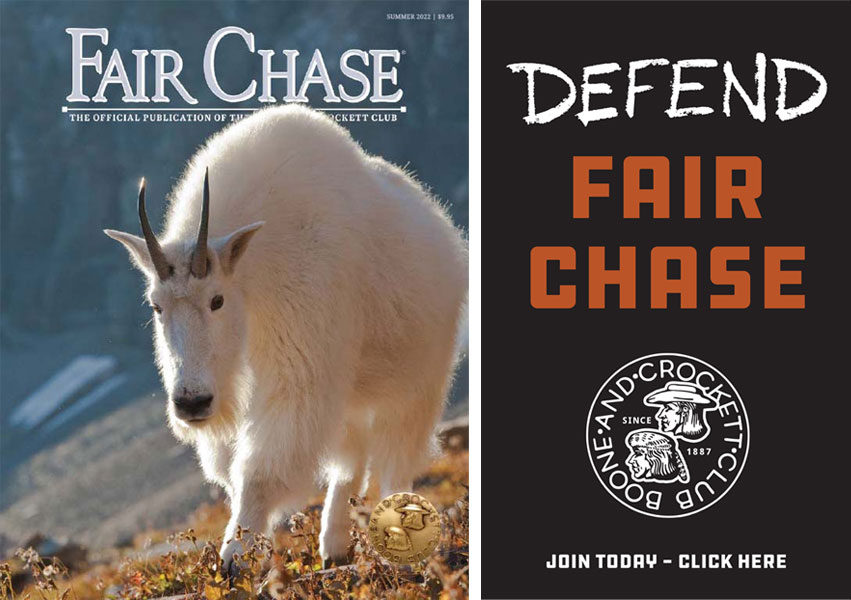Understanding Bear Predation
SCIENCE BLASTS
By John F. Organ, B&C Professional MemberExcerpt from Fall 2017 issue of Fair Chase
It’s pretty common knowledge these days that black and grizzly bears are very efficient predators of ungulate fawns and calves. Some of the earliest published accounts of black bear predation on whitetail deer were in the 1940s, although observations and reports of bear predation were low. Advances in technology, such as telemetry, have provided improved tools for wildlife researchers to study various life history aspects of animals. A number of studies in the late 1970s and early 1980s raised awareness among wildlife biologists that bears could be a major fawn and calf predator. In those days, biologists were using radio telemetry—typically a collar with a VHF transmitter—to track adult female ungulates, and occasionally fawns and calves.
In recent times, advances in telemetry have reduced the size of transmitters, facilitating their placement on fawns and calves, and have revolutionized the technology by development of satellite and GPS transmitters. Satellite transmitters are ideal for monitoring movements of widely dispersed animals, but often lack location accuracy. GPS transmitters have improved accuracy of locations and allow biologists greater flexibility and reliability in timing of locations. This all leads to better science and greater ability to reduce uncertainty in what we know about animals. It has also helped us understand bear predation.
A paper published in 2006 in the journal Ursus, published by the International Association for Bear Research and Management, discussed the role of black and brown bears as predators of ungulates in North America. The authors concluded that bear predation can limit, but generally does not regulate ungulate populations. They went further to state that while bear predation may be an important proximate cause of fawn and calf mortality, habitat quality and quantity can greatly influence this dynamic.
GPS transmitters have improved accuracy of locations and allow biologists greater flexibility and reliability in timing of locations. This all leads to better science and greater ability to reduce uncertainty in what we know about animals. It has also helped us understand bear predation.
In a recently completed series of far-reaching studies in Newfoundland, conceived and directed by Shane Mahoney, a B&C professional member, a finer understanding of how bears hunt caribou calves was realized. Dr. Nathaniel Rayl’s doctorate dissertation research at the University of Massachusetts, Amherst, under the direction of professor Todd Fuller, Shane, and myself, explored the role of black bear predation in the recent decline of caribou on the island of Newfoundland. One very interesting aspect of Nathaniel’s research was how he went about figuring out just how to hunt calves from a black bear’s perspective. Nathaniel used a scientific tool known as Resource Selection Function (RSF). A RSF is a model that provides values related to the probability that a resource unit, such as a habitat type, is used versus other resource units. In order to build reliable RSFs, a lot of field work and data collection are needed. GPS telemetry and the greater accuracy of locations of calf kills helped make this possible. A lot of on-the-ground work determining the cause of predation (predator vs other cause; bear, lynx, coyote) was needed.
So what did we learn? It appears that black bears preying on caribou calves in Newfoundland really knew what they were doing. During the early part of the calving season, when there was a big pulse in births, bears were seeking out areas where they were most successful in actu- ally killing calves—the right kind of habitat where they had greater luck. As the birth pulse declined, bears started searching out adult female caribou as a way to locate calves. When this tapered off, they resorted to searching out their regular early summer foods—vegetation and ants— occasionally encountering and killing calves.
Another aspect of Nathaniel’s study revealed that not all bears hunt caribou calves. Some bears appear to specialize in this and may travel seasonally to the calving grounds while others may use the calving grounds during non-calving seasons and use other parts of the island during calving.
How do we use this information? Any management intervention designed to reduce predation would have to be surgical to have effect. Also, habitat plays a key role in terms of predation rate. It is believed that prior to the decline of the caribou population, impacts to the habitat by the large numbers of animals likely have forced caribou into riskier habitats, where success of bears is greater. There is no simple solution.
Fortunately, the caribou population is on the rise, and it is believed that habitat quality is improving. Hopefully, a Fair Chase article will be forthcoming from Nathaniel and Shane that will provide greater detail on caribou and bears. The island of Newfoundland is a magical place, and the drama that has played out for centuries on the island between these two magnificent creatures will endure for future generations if we manage them prudently. Thanks to Shane for his vision and leadership and to Nathaniel for immersing himself in the quest for knowledge.
More Science Blasts
Read more articles about conservation, hunting, and wildlife research by John Organ, Director Emeritus of the USGS Cooperative Fish and Wildlife Research Units, and current B&C professional member.
Interested in More?
Image

|
